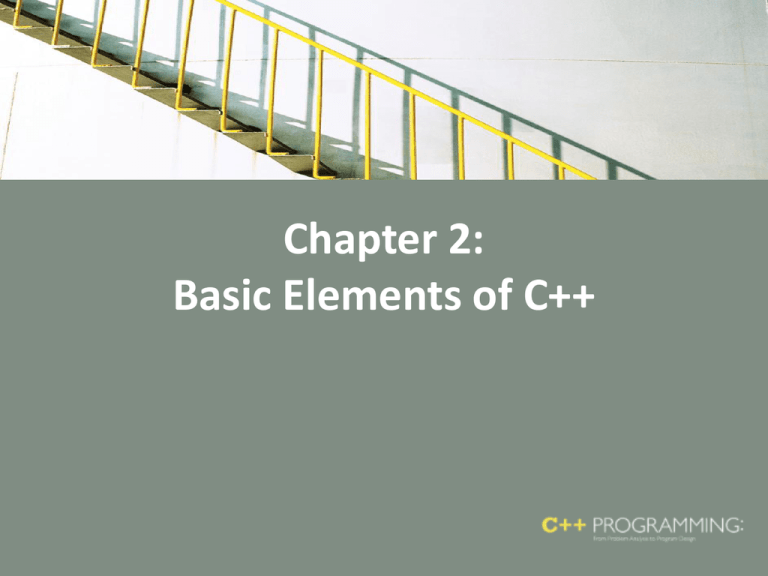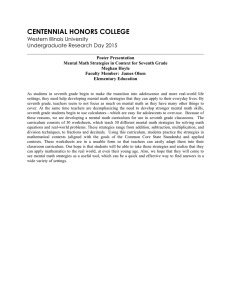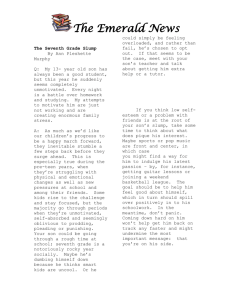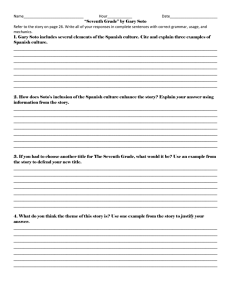Chapter 2: Basic Elements of C++
advertisement

Chapter 2:
Basic Elements of C++
Objectives
• In this chapter, you will:
– Become familiar with the basic components of a C++
program, including functions, special symbols, and
identifiers in C++
– Explore simple data types
– Discover how to use arithmetic operators
– Examine how a program evaluates arithmetic expressions
– Become familiar with the string data type
– Learn what an assignment statement is and what it does
C++ Programming: From Problem Analysis to Program Design, Seventh Edition
2
Objectives (cont’d.)
– Learn about variable declaration
– Discover how to input data into memory using input
statements
– Become familiar with the use of increment and decrement
operators
– Examine ways to output results using output statements
– Learn how to use preprocessor directives and why they are
necessary
C++ Programming: From Problem Analysis to Program Design, Seventh Edition
3
Objectives (cont’d.)
– Learn how to debug syntax errors
– Explore how to properly structure a program, including
using comments to document a program
– Become familiar with compound statements
– Learn how to write a C++ program
C++ Programming: From Problem Analysis to Program Design, Seventh Edition
4
Introduction
• Computer program
– Sequence of statements whose objective is to accomplish
a task
• Programming
– Process of planning and creating a program
• Real-world analogy: a recipe for cooking
C++ Programming: From Problem Analysis to Program Design, Seventh Edition
5
A Quick Look at a C++ Program
C++ Programming: From Problem Analysis to Program Design, Seventh Edition
6
A Quick Look at a C++ Program
(cont’d.)
• Sample run:
C++ Programming: From Problem Analysis to Program Design, Seventh Edition
7
A Quick Look at a C++ Program
(cont’d.)
C++ Programming: From Problem Analysis to Program Design, Seventh Edition
8
A Quick Look at a C++
Program(cont’d.)
C++ Programming: From Problem Analysis to Program Design, Seventh Edition
9
A Quick Look at a C++ Program
(cont’d.)
• Variable: a memory location whose contents can be
changed
Figure 2-2 Memory allocation
Figure 2-3 Memory spaces after the statement length = 6.0; executes
C++ Programming: From Problem Analysis to Program Design, Seventh Edition
10
The Basics of a C++ Program
• Function (or subprogram): collection of statements;
when executed, accomplishes something
– May be predefined or standard
• Syntax rules: rules that specify which statements
(instructions) are legal or valid
• Semantic rules: determine the meaning of the
instructions
• Programming language: a set of rules, symbols, and
special words
C++ Programming: From Problem Analysis to Program Design, Seventh Edition
11
Comments
• Comments are for the reader, not the compiler
• Two types:
– Single line: begin with //
// This is a C++ program.
// Welcome to C++ Programming.
– Multiple line: enclosed between /* and */
/*
You can include comments that can
occupy several lines.
*/
C++ Programming: From Problem Analysis to Program Design, Seventh Edition
12
Special Symbols
• Token: the smallest individual unit of a program
written in any language
• C++ tokens include special symbols, word symbols,
and identifiers
• Special symbols in C++ include:
C++ Programming: From Problem Analysis to Program Design, Seventh Edition
13
Reserved Words (Keywords)
• Reserved word symbols (or keywords):
– Cannot be redefined within program
– Cannot be used for anything other than their intended use
Examples:
–
–
–
–
–
–
–
int
float
double
char
const
void
return
C++ Programming: From Problem Analysis to Program Design, Seventh Edition
14
Identifiers
• Identifier: the name of something that appears in a
program
– Consists of letters, digits, and the underscore character (_)
– Must begin with a letter or underscore
• C++ is case sensitive
– NUMBER is not the same as number
• Two predefined identifiers are cout and cin
• Unlike reserved words, predefined identifiers may be
redefined, but it is not a good idea
C++ Programming: From Problem Analysis to Program Design, Seventh Edition
15
Identifiers (cont’d.)
• Legal identifiers in C++:
– first
– conversion
– payRate
C++ Programming: From Problem Analysis to Program Design, Seventh Edition
16
Whitespaces
• Every C++ program contains whitespaces
– Include blanks, tabs, and newline characters
• Used to separate special symbols, reserved words,
and identifiers
• Proper utilization of whitespaces is important
– Can be used to make the program more readable
C++ Programming: From Problem Analysis to Program Design, Seventh Edition
17
Data Types
• Data type: set of values together with a set of
operations
• C++ data types fall into three categories:
– Simple data type
– Structured data type
– Pointers
C++ Programming: From Problem Analysis to Program Design, Seventh Edition
18
Simple Data Types
• Three categories of simple data
– Integral: integers (numbers without a decimal)
• Can be further categorized:
– char, short, int, long, bool, unsigned
char, unsigned short, unsigned int,
unsigned long
– Floating-point: decimal numbers
– Enumeration type: user-defined data type
C++ Programming: From Problem Analysis to Program Design, Seventh Edition
19
Simple Data Types (cont’d.)
• Different compilers may allow different ranges of
values
C++ Programming: From Problem Analysis to Program Design, Seventh Edition
20
int Data Type
• Examples:
-6728
0
78
+763
• Cannot use a comma within an integer
– Commas are only used for separating items in a list
C++ Programming: From Problem Analysis to Program Design, Seventh Edition
21
bool Data Type
• bool type
– Two values: true and false
– Manipulate logical (Boolean) expressions
• true and false
– Logical values
• bool, true, and false
– Reserved words
C++ Programming: From Problem Analysis to Program Design, Seventh Edition
22
char Data Type
• The smallest integral data type
• Used for single characters: letters, digits, and special
symbols
• Each character is enclosed in single quotes
– 'A', 'a', '0', '*', '+', '$', '&'
• A blank space is a character
– Written ' ', with a space left between the single quotes
C++ Programming: From Problem Analysis to Program Design, Seventh Edition
23
char Data Type (cont’d.)
• Different character data sets exist
• ASCII: American Standard Code for Information
Interchange
– Each of 128 values in ASCII code set represents a different
character
– Characters have a predefined ordering based on the ASCII
numeric value
• Collating sequence: ordering of characters based on
the character set code
C++ Programming: From Problem Analysis to Program Design, Seventh Edition
24
Floating-Point Data Types
• C++ uses scientific notation to represent real
numbers (floating-point notation)
C++ Programming: From Problem Analysis to Program Design, Seventh Edition
25
Floating-Point Data Types (cont’d.)
• float: represents any real number
– Range: -3.4E+38 to 3.4E+38 (four bytes)
• double: represents any real number
– Range: -1.7E+308 to 1.7E+308 (eight bytes)
• Minimum and maximum values of data types are
system dependent
C++ Programming: From Problem Analysis to Program Design, Seventh Edition
26
Floating-Point Data Types (cont’d.)
• Maximum number of significant digits (decimal
places) for float values: 6 or 7
• Maximum number of significant digits for double:
15
• Precision: maximum number of significant digits
– Float values are called single precision
– Double values are called double precision
C++ Programming: From Problem Analysis to Program Design, Seventh Edition
27
Data Types, Variables, and
Assignment Statements
• To declare a variable, must specify its data type
• Syntax: dataType identifier;
• Examples:
int counter;
double interestRate;
char grade;
• Assignment statement: variable = expression
interestRate = 0.05;
C++ Programming: From Problem Analysis to Program Design, Seventh Edition
28
Arithmetic Operators, Operator
Precedence, and Expressions
• C++ arithmetic operators:
–
–
–
–
–
+ addition
- subtraction
* multiplication
/ division
% modulus (or remainder) operator
• +, -, *, and / can be used with integral and floatingpoint data types
• Use % only with integral data types
C++ Programming: From Problem Analysis to Program Design, Seventh Edition
29
Arithmetic Operators, Operator
Precedence, and Expressions (cont’d.)
• When you use / with integral data types, the integral
result is truncated (no rounding)
• Arithmetic expressions: contain values and
arithmetic operators
• Operands: the number of values on which the
operators will work
• Operators can be unary (one operand) or binary (two
operands)
C++ Programming: From Problem Analysis to Program Design, Seventh Edition
30
Order of Precedence
• All operations inside of () are evaluated first
• *, /, and % are at the same level of precedence and
are evaluated next
• + and – have the same level of precedence and are
evaluated last
• When operators are on the same level
– Performed from left to right (associativity)
• 3 * 7 - 6 + 2 * 5 / 4 + 6 means
(((3 * 7) – 6) + ((2 * 5) / 4 )) + 6
C++ Programming: From Problem Analysis to Program Design, Seventh Edition
31
Expressions
• Integral expression: all operands are integers
– Yields an integral result
– Example: 2 + 3 * 5
• Floating-point expression: all operands are floatingpoint
– Yields a floating-point result
– Example: 12.8 * 17.5 - 34.50
C++ Programming: From Problem Analysis to Program Design, Seventh Edition
32
Mixed Expressions
• Mixed expression:
– Has operands of different data types
– Contains integers and floating-point
• Examples of mixed expressions:
2 + 3.5
6 / 4 + 3.9
5.4 * 2 – 13.6 + 18
/
2
C++ Programming: From Problem Analysis to Program Design, Seventh Edition
33
Mixed Expressions (cont’d.)
• Evaluation rules:
– If operator has same types of operands
• Evaluated according to the type of the operands
– If operator has both types of operands
• Integer is changed to floating-point
• Operator is evaluated
• Result is floating-point
– Entire expression is evaluated according to precedence
rules
C++ Programming: From Problem Analysis to Program Design, Seventh Edition
34
Type Conversion (Casting)
• Implicit type coercion: when value of one type is
automatically changed to another type
• Cast operator: provides explicit type conversion
static_cast<dataTypeName>(expression)
C++ Programming: From Problem Analysis to Program Design, Seventh Edition
35
Type Conversion (Casting) (cont’d.)
C++ Programming: From Problem Analysis to Program Design, Seventh Edition
36
string Type
• Programmer-defined type supplied in ANSI/ISO
Standard C++ library
• Sequence of zero or more characters enclosed in
double quotation marks
• Null (or empty): a string with no characters
• Each character has a relative position in the string
– Position of first character is 0
• Length of a string is number of characters in it
– Example: length of "William Jacob" is 13
C++ Programming: From Problem Analysis to Program Design, Seventh Edition
37
Variables, Assignment Statements,
and Input Statements
• Data must be loaded into main memory before it can
be manipulated
• Storing data in memory is a two-step process:
– Instruct computer to allocate memory
– Include statements to put data into memory
C++ Programming: From Problem Analysis to Program Design, Seventh Edition
38
Allocating Memory with Constants and
Variables
• Named constant: memory location whose content
can’t change during execution
• Syntax to declare a named constant:
• In C++, const is a reserved word
C++ Programming: From Problem Analysis to Program Design, Seventh Edition
39
Allocating Memory with Constants and
Variables (cont’d.)
• Variable: memory location whose content may
change during execution
• Syntax to declare a named constant:
C++ Programming: From Problem Analysis to Program Design, Seventh Edition
40
Putting Data into Variables
• Ways to place data into a variable:
– Use C++’s assignment statement
– Use input (read) statements
C++ Programming: From Problem Analysis to Program Design, Seventh Edition
41
Assignment Statement
• The assignment statement takes the form:
• Expression is evaluated and its value is assigned to
the variable on the left side
• A variable is said to be initialized the first time a
value is placed into it
• In C++, = is called the assignment operator
C++ Programming: From Problem Analysis to Program Design, Seventh Edition
42
Assignment Statement (cont’d.)
C++ Programming: From Problem Analysis to Program Design, Seventh Edition
43
Saving and Using the Value of an
Expression
• To save the value of an expression:
– Declare a variable of the appropriate data type
– Assign the value of the expression to the variable that was
declared
• Use the assignment statement
• Wherever the value of the expression is needed, use
the variable holding the value
C++ Programming: From Problem Analysis to Program Design, Seventh Edition
44
Declaring & Initializing Variables
• Not all types of variables are initialized automatically
• Variables can be initialized when declared:
int first=13, second=10;
char ch=' ';
double x=12.6;
• All variables must be initialized before they are used
– But not necessarily during declaration
C++ Programming: From Problem Analysis to Program Design, Seventh Edition
45
Input (Read) Statement
• cin is used with >> to gather input
• This is called an input (read) statement
• The stream extraction operator is >>
• For example, if miles is a double variable
cin >> miles;
– Causes computer to get a value of type double and
places it in the variable miles
C++ Programming: From Problem Analysis to Program Design, Seventh Edition
46
Input (Read) Statement (cont’d.)
• Using more than one variable in cin allows more
than one value to be read at a time
• Example: if feet and inches are variables of type
int, this statement:
cin >> feet >> inches;
– Inputs two integers from the keyboard
– Places them in variables feet and inches respectively
C++ Programming: From Problem Analysis to Program Design, Seventh Edition
47
C++ Programming: From Problem Analysis to Program Design, Seventh Edition
48
Increment and Decrement Operators
• Increment operator: increase variable by 1
– Pre-increment: ++variable
– Post-increment: variable++
• Decrement operator: decrease variable by 1
– Pre-decrement: --variable
– Post-decrement: variable—
• What is the difference between the following?
x = 5;
y = ++x;
x = 5;
y = x++;
C++ Programming: From Problem Analysis to Program Design, Seventh Edition
49
Output
• The syntax of cout and << is:
– Called an output statement
• The stream insertion operator is <<
• Expression evaluated and its value is printed at the
current cursor position on the screen
C++ Programming: From Problem Analysis to Program Design, Seventh Edition
50
Output (cont’d.)
• A manipulator is used to format the output
– Example: endl causes insertion point to move to
beginning of next line
C++ Programming: From Problem Analysis to Program Design, Seventh Edition
51
Output (cont’d.)
• The new line character is '\n'
– May appear anywhere in the string
cout << "Hello there.";
cout << "My name is James.";
Output:
Hello there.My name is James.
cout << "Hello there.\n";
cout << "My name is James.";
Output :
Hello there.
My name is James.
C++ Programming: From Problem Analysis to Program Design, Seventh Edition
52
Output (cont’d.)
C++ Programming: From Problem Analysis to Program Design, Seventh Edition
53
Preprocessor Directives
• C++ has a small number of operations
• Many functions and symbols needed to run a C++
program are provided as collection of libraries
• Every library has a name and is referred to by a
header file
• Preprocessor directives are commands supplied to
the preprocessor program
• All preprocessor commands begin with #
• No semicolon at the end of these commands
C++ Programming: From Problem Analysis to Program Design, Seventh Edition
54
Preprocessor Directives (cont’d.)
• Syntax to include a header file:
• For example:
#include <iostream>
– Causes the preprocessor to include the header file
iostream in the program
• Preprocessor commands are processed before the
program goes through the compiler
C++ Programming: From Problem Analysis to Program Design, Seventh Edition
55
namespace and Using cin and cout in
a Program
• cin and cout are declared in the header file
iostream, but within std namespace
• To use cin and cout in a program, use the
following two statements:
#include <iostream>
using namespace std;
C++ Programming: From Problem Analysis to Program Design, Seventh Edition
56
Using the string Data Type in a
Program
• To use the string type, you need to access its
definition from the header file string
• Include the following preprocessor directive:
#include <string>
C++ Programming: From Problem Analysis to Program Design, Seventh Edition
57
Creating a C++ Program
• A C++ program is a collection of functions, one of
which is the function main
• The first line of the function main is called the
heading of the function:
– int main()
• The statements enclosed between the curly braces ({
and }) form the body of the function
C++ Programming: From Problem Analysis to Program Design, Seventh Edition
58
Creating a C++ Program (cont’d.)
• A C++ program contains two types of statements:
– Declaration statements: declare things, such as variables
– Executable statements: perform calculations, manipulate
data, create output, accept input, etc.
C++ Programming: From Problem Analysis to Program Design, Seventh Edition
59
Creating a C++ Program (cont’d.)
• C++ program has two parts:
– Preprocessor directives
– The program
• Preprocessor directives and program statements
constitute C++ source code (.cpp)
• Compiler generates object code (.obj)
• Executable code is produced and saved in a file with
the file extension .exe
C++ Programming: From Problem Analysis to Program Design, Seventh Edition
60
Debugging: Understanding and Fixing
Syntax Errors
• Compile a program
– Compiler will identify the syntax errors
– Specifies the line numbers where the errors occur
Example2_Syntax_Errors.cpp
c:\chapter 2 source code\example2_syntax_errors.cpp(9) : error
C2146: syntax error :
missing ';' before identifier 'num'
c:\chapter 2 source code\example2_syntax_errors.cpp(11) :
error C2065: 'tempNum' :
undeclared identifier
C++ Programming: From Problem Analysis to Program Design, Seventh Edition
61
Program Style and Form: Syntax
• Syntax rules: indicate what is legal and what is not
legal
• Errors in syntax are found in compilation
int x;
int y
double z;
//Line 1
//Line 2: error
//Line 3
y = w + x;
//Line 4: error
C++ Programming: From Problem Analysis to Program Design, Seventh Edition
62
Use of Blanks
• In C++, you use one or more blanks to separate
numbers when data is input
• Blanks are also used to separate reserved words and
identifiers from each other and from other symbols
• Blanks must never appear within a reserved word or
identifier
C++ Programming: From Problem Analysis to Program Design, Seventh Edition
63
Use of Semicolons, Brackets, and
Commas
• All C++ statements end with a semicolon
– Also called a statement terminator
• { and } are not C++ statements
– Can be regarded as delimiters
• Commas separate items in a list
C++ Programming: From Problem Analysis to Program Design, Seventh Edition
64
Semantics
• Semantics: set of rules that gives meaning to a
language
– Possible to remove all syntax errors in a program and still
not have it run
– Even if it runs, it may still not do what you meant it to do
• Ex: 2 + 3 * 5 and (2 + 3) * 5
are both syntactically correct expressions, but have
different meanings
C++ Programming: From Problem Analysis to Program Design, Seventh Edition
65
Naming Identifiers
• Identifiers can be self-documenting:
– CENTIMETERS_PER_INCH
• Avoid run-together words :
– annualsale
– Solution:
• Capitalizing the beginning of each new word: annualSale
• Inserting an underscore just before a new word: annual_sale
C++ Programming: From Problem Analysis to Program Design, Seventh Edition
66
Prompt Lines
• Prompt lines: executable statements that inform the
user what to do
cout << "Please enter a number between 1 and 10 and "
<< "press the return key" << endl;
cin >> num;
• Always include prompt lines when input is needed
from users
C++ Programming: From Problem Analysis to Program Design, Seventh Edition
67
Documentation
• A well-documented program is easier to understand
and modify
• You use comments to document programs
• Comments should appear in a program to:
– Explain the purpose of the program
– Identify who wrote it
– Explain the purpose of particular statements
C++ Programming: From Problem Analysis to Program Design, Seventh Edition
68
Form and Style
• Consider two ways of declaring variables:
– Method 1
int feet, inch;
double x, y;
– Method 2
int feet,inch;double x,y;
• Both are correct; however, the second is hard to read
C++ Programming: From Problem Analysis to Program Design, Seventh Edition
69
More on Assignment Statements
• Two forms of assignment
– Simple and compound
– Compound operators provide more concise notation
• Compound operators: +=, -=, *=, /=, %=
• Simple assignment
x = x * y;
• Compound assignment
x *= y;
C++ Programming: From Problem Analysis to Program Design, Seventh Edition
70
Summary
• C++ program: collection of functions, one of which is
always called main
• Identifiers consist of letters, digits, and underscores,
and begins with letter or underscore
• The arithmetic operators in C++ are addition (+),
subtraction (-), multiplication (*), division (/), and
modulus (%)
• Arithmetic expressions are evaluated using the
precedence associativity rules
C++ Programming: From Problem Analysis to Program Design, Seventh Edition
71
Summary (cont’d.)
• All operands in an integral expression are integers
• All operands in a floating-point expression are
decimal numbers
• Mixed expression: contains both integers and
decimal numbers
• Use the cast operator to explicitly convert values
from one data type to another
• A named constant is initialized when declared
• All variables must be declared before used
C++ Programming: From Problem Analysis to Program Design, Seventh Edition
72
Summary (cont’d.)
• Use cin and stream extraction operator >> to input
from the standard input device
• Use cout and stream insertion operator << to
output to the standard output device
• Preprocessor commands are processed before the
program goes through the compiler
• A file containing a C++ program usually ends with the
extension .cpp
C++ Programming: From Problem Analysis to Program Design, Seventh Edition
73




